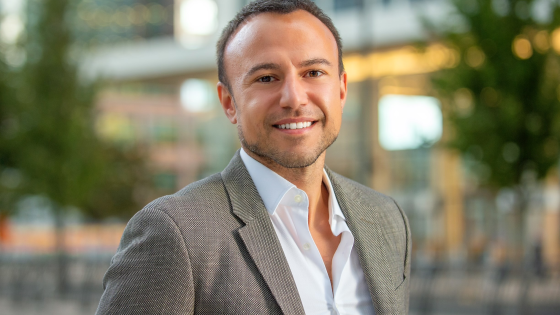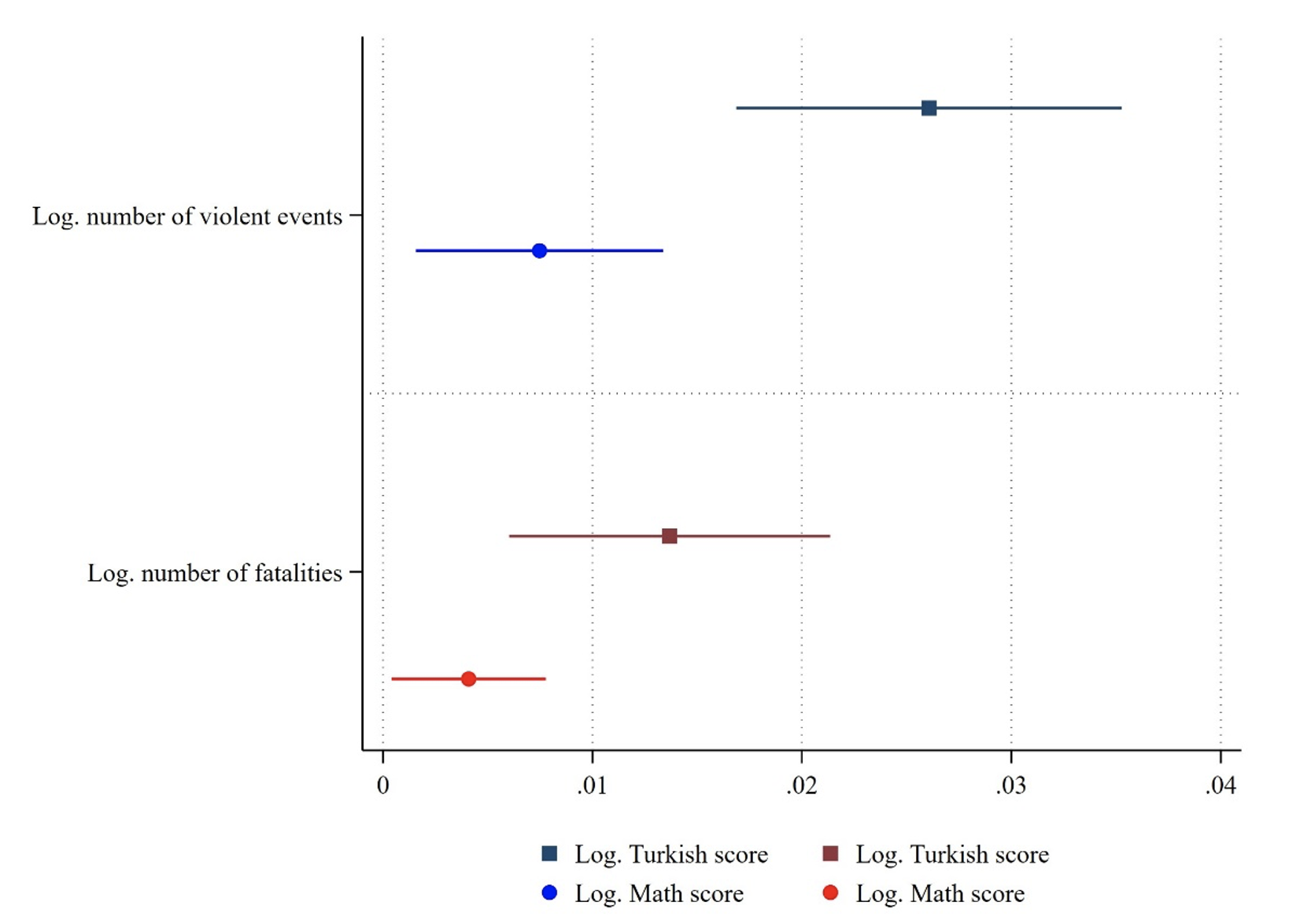The humanitarian challenges of an unprecedented global displacement crisis – which saw 1.4% of the world’s population forcibly displaced by 2022, tripling the 0.4% recorded in 1990 (UNHCR 2022) – are profound and extensive. Developing countries shoulder most of the burden, hosting approximately 75% of the world’s refugees, nearly half of them children (EBRD 2023). Persistent crises in countries such as Syria, Afghanistan, Ukraine, Venezuela, Libya, and Yemen indicate that achieving political stability will remain elusive for the foreseeable future.
Against this backdrop, our new paper (Aksoy et al. 2024) focuses on a previously underexplored dimension: how persistent violence in the districts of origin affects refugee integration, as measured by educational achievement. The existing empirical evidence indicates that the effects of violent conflict on education are highly heterogeneous (e.g. Verwimp and Van Bavel 2014, Rodriguez and Sanchez 2012, Bertoni et al. 2019, Akbulut-Yuksel 2022). As outlined in Brück et al. (2022), the sign and magnitude of the effects depend, among other factors, on the type of conflict (i.e. civil conflict, inter-state war, terrorism, etc.), the type of violent events (killings, abduction, etc.), gender, and the education outcome considered (school enrolment, attainment, etc.).
Unresolved conflicts, particularly in Syria, cast a long shadow on the prospects of return, prompting a closer examination of how this protracted instability affects human capital investment decisions – which serve as a proxy for integration efforts, aspirations, and return expectations – among refugee children in Türkiye.
Two opposing mechanisms
We estimate the causal effect of ongoing violence in Syria on the educational outcomes of refugee children in Türkiye. The heightened levels of concurrent violence may influence educational attainment through two opposing mechanisms. On the one hand, the trauma experienced may worsen schooling outcomes. On the other, the continued violence may alter expectations, prompting refugee children to reassess their beliefs about the likelihood of returning to Syria. This despair, in turn, may lead to more investment in their educational development, in an effort to integrate more effectively into their host communities.
To unravel this puzzle, we use individual-level administrative panel data that comprehensively document the academic performance of Syrian students and merge it with detailed information regarding the timing, location, and intensity of violence in their hometowns in Syria. As such, our empirical strategy exploits within-origin district-academic semester variation in conflict. Our outcomes include the end-of-semester scores from mandatory courses (Turkish language and math) taken by all registered students, and their absenteeism records. Our dataset includes all refugee and native students registered in Turkish public schools across four provinces: Ankara, Bursa, Gaziantep, and Sanliurfa.
Main results
Figure 1 reports our main results, where our analysis uses two different measures of the treatment: the logarithm of the number of violent events and the logarithm of the number of fatalities.
For both measures of violence, we find that the Turkish language and math scores of Syrian students improve in response to heightened levels of violence in their place of origin. For example, a shift from the 25th to the 75th percentile in the casualties treatment leads to an average 6% increase in Turkish scores. To put this in context, it’s comparable to progressing from the 55th to the 60th percentile in the distribution of Turkish scores among Syrian students, resulting in an average score increase of 3.5 points. If the number of fatalities rises from the 25th to the 75th percentile, math scores are likely to increase by a little over 1% on average. This increase corresponds to students in the 75th percentile or above achieving a gain of one point in their math scores.
These results suggest that heightened violence in their hometowns is associated with a more significant improvement in Turkish language scores compared to math scores among Syrian refugees. This may reflect the fact that children are putting in considerable effort to integrate into their new society. As violence intensifies in their hometowns, Syrian students proactively invest in improving their Turkish language skills, a crucial step in achieving effective integration, which enhances their communication and participation in educational and social activities. We also find a modest increase in math scores, which may reflect the increased academic effort stemming from the reduced likelihood of return, or may reflect improved language skills needed for maths.
Figure 1 Impact of violence on Turkish language and maths scores
Notes: Figure showing estimates from four separate regressions. The dependent variable is indicated in the legend and the treatment variables are indicated on the vertical axis. The data is at the individual-semester level. Standard errors are clustered at the district level and whiskers correspond to 95% confidence intervals.
Do higher levels of violence affect absenteeism among Syrian students?
We also analyse the number of school absences per semester, serving as an indicator of school attachment among Syrian students. While school attachment does not directly reflect academic achievement, it captures the students’ willingness to attend school and engage in educational activities, including exams. Across our conflict variables, we consistently find null results for both outcomes. If anything, an increase in violence may be associated with a reduction in the number of missed school days. These findings provide evidence of enhanced school attachment in response to heightened violence in hometowns, which aligns with our prior observations regarding Turkish language and math scores.
Does naturalisation status matter for the response to hometown violence?
Our findings also show that the impact of violence on naturalised students is much smaller compared to their non-naturalised counterparts. This difference may be attributed to the fact that naturalised status already offers a permanent option to stay in Turkiye.
Are there spillover effects to Turkish students?
We also find possible spillover effects on Turkish students. In particular, the spillover effects are stronger in school years with a substantial concentration of refugee students. Specifically, a one-unit increase in the weighted index of violent events results in a 6.1% increase in Turkish scores and a 6.7% increase in math scores.
Concluding remarks
Our findings have important implications. Given the evident improvement in language scores among refugee students and related positive spillover effects to native students, there is a case for prioritising language support measures. This may involve allocating additional resources to develop targeted courses and specialised tutoring programmes. Such initiatives can effectively expedite the language acquisition and educational progress of refugees while also fostering interaction and mutual understanding with their Turkish peers. Tailored academic and social support should be a focus, such as academic assistance and counselling, alongside programmes designed to facilitate their integration into the host country.
To sum up, our research highlights the influence of events in the refugees’ home countries on the integration of refugee children into the education system and, consequently, into the host society. It is crucial for authorities to formulate educational policies that prioritise inclusiveness, nurture academic achievement, and foster mutual understanding among students from different backgrounds.
References
Akbulut-Yuksel, M (2022), “Unaccounted long-term health cost of wars on wartime children”, VoxEU.org, 10 May.
Aksoy, C G, G Khanna, V Marino and S Tumen (2024), “Hometown Conflict and Refugees’ Integration Efforts”, CEPR Discussion Paper 18918.
Bertoni, E, M Di Maio, V Molini and R Nistico (2019), “Education is forbidden: The effect of the Boko Haram conflict on education in North-East Nigeria”, Journal of Development Economics 141: 102249.
Brück, T, M Di Maio and S Miaari (2022), “Learning the hard way: The effect of conflict on education”, VoxEU.org, 19 April.
EBRD (2023), “Transitions big and small”, 21 November.
Rodriguez, C and F Sanchez (2012), “Armed conflict exposure, human capital investments, and child labor: evidence from Colombia”, Defence and Peace Economics 23(2): 161–84.
UNHCR (2022), “Global trends: Forced displacement in 2022”, UN Refugee Agency.
Verwimp, P and J Van Bavel (2014), “Schooling, violent conflict, and gender in Burundi”, World Bank Economic Review 28(2): 384–411.








